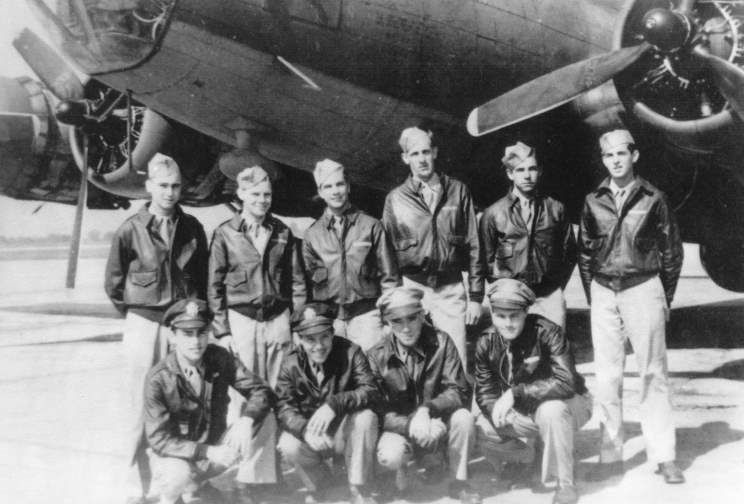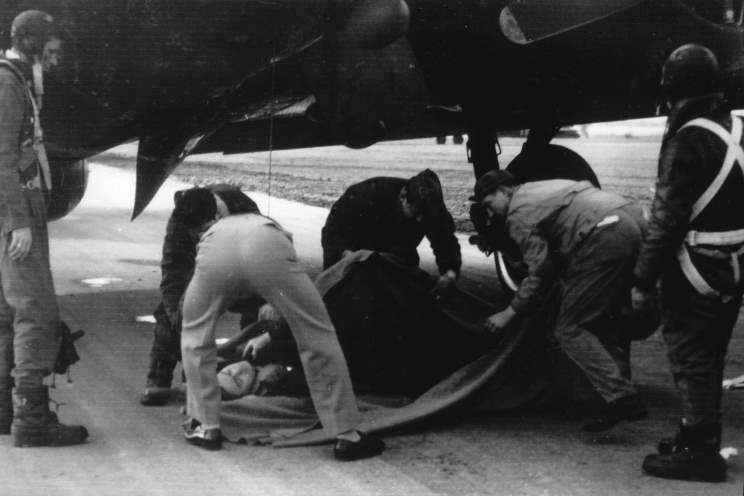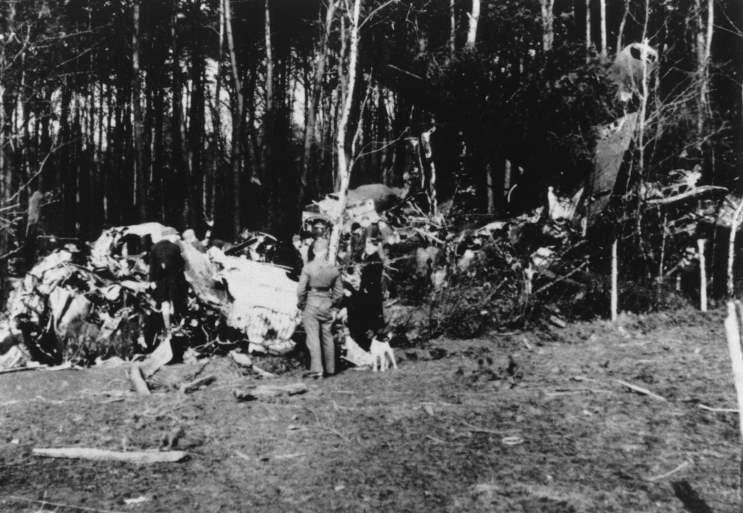Last Ride In The Shamrock Special |
|
By Trudie Gerstemeier |
When war was declared in 1941, it seemed that the American men had one thought in mind - "Gotta go and fight for freedom" - Patriotism in the U.S. was like a blanket over the country and, Robert E. "Bob" Gerstemeier, having just graduated from high school, was part of that run on the recruiting office. He enlisted in October of 1942. After going through all the basic training, which in those days only lasted two weeks because of the need for servicemen, he went on to Keesler Field, Lockheed Vega in Burbank, California, and gunnery school in Alexandria, Louisiana and finishing in Las Vegas in a B-17F. In 1943 he was a member of the new replacements that boarded the Queen Mary in New York and sailed to England. Bob and his fellow crew members were stationed on an English base, Station 121, Bassingbourne. The 8th Air Force, 2nd Division of the U.S. Army Air Corp, 91st Bombardment Group consisted of four squadrons of bombers: 322nd, 323rd, 324th and the 401st. This included ground crew, office personnel and later joined by fighter squadrons. The B-17F was the plane of the day, the G's came a little later. They had the chin turret for extra fire power. The individual crew members did not always fly together. During down time, one crew member may have had to fill in for another member of another crew. Bob's crew did not have an assigned plane, so they flew any available plane. Among them were "Hitler's Hearse", "Shamrock Special", and "My Beloved Too". Each crew consisted of ten members: Pilot, Co-pilot, Navigator and Bombardier as the four Officers, the six Sergeants: flight engineer was a Tech Sergeant and the rest were Staff Sergeants. |
 |
The B-17F "Shamrock Special" seen in January 1944.
Front row from left to right: Lt. Irving Piacintini (pilot), Lt. Jim Rogers (co-pilot), Lt. Bernie Hart (Navigator) and Lt. Bill Merkert (bombardier). Back row from left to right: T/SGT Robert E. "Bob" Gerstemeier (flight engineer and top turret gunner), SSG Bob Miller (waist gunner), T/SGT Jack Wolstenholme (radio man), SSGT Bob Dodge (waist gunner), SSGT Glenn Selter (tail gunner) and SSGT Harry Rhode (ball turret gunner). |
The requirements at that time were that you flew 25 missions before you could be rotated home, unless something serious happened. Bob flew five missions before an FW-190 formation came out of the sun during a mission over Brunswick, Germany and fired a 22caliber cannon shell into the fuselage of "The Shamrock Special". It grazed a bomb that had not been armed yet after rearranging the bomb bay doors that had been opened on approach to target. After the shell had exited the bomb bay it severed Bob's right leg below the knee. When losing his balance on the top turret platform, Bob tapped the Pilot on the shoulder, who turned long enough to see the resulting damage and motioned Bob to drop down to the walkway that ran the length of the plane. The navigator assisted Bob and immediately started a tourniquet on the leg and gave Bob a dose of morphine. Bob laid on that catwalk for five hours until they got back to England. This was January 30, 1944, a day that Bob never forgot. It was also the end of the war for this airman. |
 |
January 30, 1944: T/SGT Robert E. Gerstemeier being removed from the Shamrock Special after being severely wounded during the mission. |
He spent the rest of the time in a field hospital, then arrangements were made and Bob was sent to Walter Reed Hospital in Washington, D.C. where he spent his remaining time in the Air Force recuperating and in therapy until he and his new leg could adjust to being home. Bob received his Honorable Medical Discharge in September, 1944. In the interim several of the crew were killed or wounded and finally on February 21, 1944, the crew, flying the B-17 "My Beloved Too" noticed two engines on fire and dropped out of formation on a mission to bomb an airfield near Munster, Germany. They were immediately attacked by a formation of nine ME-109 fighters and crashed into a woods near Münster. The pilot and co-pilot were killed and the rest of the crew were taken prisoner until the end of the war. During the crash one engine broke loose from the fuselage and skidded across the street killing a little German boy riding his bike. |
 |
The remains of the B-17 "My Beloved Too" near Münster, Germany. |
After World War II, the families at home were not really aware of the adjustment the returning veterans had to make and Bob was one of those brave men who had signed that blank check to his country and had given his best. Only few of us can understand the trauma involved. Bob got back home and put on a nonchalant mask hiding his true feelings. He got married, got a job and thought that he could "fake it". After ten years and six children, he found that the role he was playing was no longer challenging and the adjustment was not coming. Trouble reared its ugly head and in January of 1955, after losing his home and children, he moved in with his aunt and uncle. He got a job with the suburban utility company, but his heart was not fully awake yet. Fate had other plans, and in April of that year, Bob and his older brother and sister-in-law stopped in a local pub to share a nightcap. Through the huge bouquet of Easter flowers Bob caught a glimpse of three people having a welcome home toast on the other side of the bar. The two girls were fresh from a Florida tan and the single one sported a blonde hairdo that caught Bob's eye. After that night Bob's attitude changed and we were hardly ever apart. A few months later Bob and I started what turned into a seven -year court battle for custody of his children. In early 1962 Bob was awarded his children, setting a precedent in the County courts to be the first man to gain custody of all his children. Again fate had other plans, and in 1959, we were blessed with a set of twins, giving us eight children to raise; but wait-in 1962 there was another son and in 1966, our youngest son was born. I loved children; but I got the whole team. Bob and I bought a farm so the children would have a great place to grow, what with a couple of horses, a steer or two and a few pigs; plus a large vegetable garden and all of this patrolled by two German shepherds. That isn't all, is it? No-Bob got in touch with the old Bomber Group that was reorganizing into the 91st Bomb Group Memorial Association and became the East Coast Secretary, being responsible for much paperwork, getting in touch with members of the 91st, sending out the newspaper aptly named "The Ragged Irregular" since that had been the nickname of the Bomb Group during the war. Planning and hosting get-togethers, reunions, etc., took up much time and effort, but Bob was alive again. We took the Bomb Group members back to their base in England and into Europe several times and found the trips very enjoyable. Then in 1982, when Bob retired from work after 37 long years, we moved to Florida and all that work caught up with Bob and his health began to suffer. The prosthesis he had to wear from the war and all the stress finally began to take its toll. In 1994, he was found to be totally disabled by the Veterans Association, and given additional benefits. For his 70th birthday present he received a flight in the B-17, "909" that was a plane of the 91st during the war. And then a wonderful group of men brought a B-17 into Vero Beach called "Aluminum Overcast" and invited Bob to fly with them into Orlando. In 2004, the family decided to honor Bob with a Memorial Plaque placed in the Mighty 8th Air Force Memorial Museum and soon after that we found that Bob's memory was going away. |
 |
The memorial plaque donated by the Gerstemeier family for the crewmen of Shamrock Special on display at the Mighty Eighth Air Force Museum in Savannah, Georgia. |
In February, 2006, Bob took his Last Flight in the Phantom B-17 and left us to take the Hand of God. |
In loving memory of my husband Bob Gerstemeier -Trudie Gerstemeier © 2011 Trudie Gerstemeier all rights reserved |
Page published July 17, 2011 |